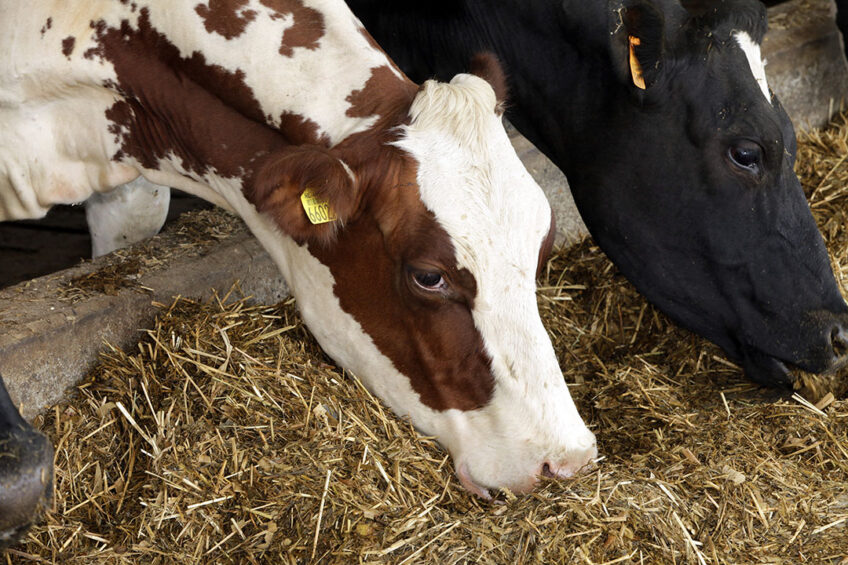Finding ways to reduce ammonia emissions on dairy farms

Livestock-heavy countries around the world are under pressure to reduce their ammonia emissions. We look at methods that can reduce these emissions.
Agriculture is the dominant source of ammonia emissions with the sector accounting for around 88% of total UK emissions and the main sources identified as livestock manures, slurry and mineral fertilisers.

Cattle farming is responsible for 44% of the UK’s total ammonia emissions where most ammonia losses come from manure spreading on land (48% of cattle emissions) and from livestock housing (34% of cattle emissions), see Figure 1.
Dairy farms have been labelled as one of the more intense producers of ammonia and have been set targets or quotas in many countries in an overall effort to cut emissions.
Figure 1 – Northern Ireland agricultural ammonia emissions (2018) by livestock and fertiliser category.

Click here to enlarge this figure
Best methods to reduce ammonia
There are a number of studies underway to research the best methods of reducing the ammonia, one of which is the Dairy-4-Future project currently underway in Northern Ireland and a few other countries. This research has shown that, depending on the farm management practices, it is possible to reduce ammonia emissions by a number of methods, including:
- Reducing dietary crude protein;
- Applying slurry using LESSE (Low Emission Slurry Spreading Equipment);
- Covering above ground slurry stores;
- Increasing the length of the grazing season;
- Using protected urea or calcium ammonium nitrate fertiliser.
Dairy-4-Future is a €3.8 million Atlantic Interreg funded project, which aims to improve the sustainability of dairy farming in the Atlantic region of Europe. Through a consortium of 11 partners, from Scotland to the Azores, the project aims to increase the competitiveness, sustainability and resilience of dairy farms in these Atlantic regions.
At the heart of the project are a group of 100 pilot farmers and 10 experimental and demonstration farms drawn from all the regions involved, 10 of which are in Northern Ireland.
So what is the problem with ammonia?
Ammonia is an air pollutant and when it reacts with other atmospheric pollutants, it can negatively impact human health. Ammonia is not a greenhouse gas, but can indirectly result in increased emissions of nitrous oxide which is a potent greenhouse gas. Deposition of ammonia on land can damage sensitive plant species in protected habitats.
What is happening?
Ammonia emissions on the 10 pilot farms in Northern Ireland are being calculated from detailed farm management data and are being analysed by Teagasc, Moorepark.
Ammonia emissions calculated from the data have been expressed per 1,000 kg of fat and protein corrected milk yield (FPCM). The ammonia emissions analysis results are presented in Table 1. These results have been fed back to the participating farmers to indicate the source of the emissions, and how they may be reduced.
Table 1 – Northern Ireland Dairy-4-Future pilot farms Ammonia emissions (NH3/1,000 kg FPCM).

Click here to enlarge this table
Nitrogen excretion
One way to reduce the quantity of ammonia available to be released is to lower the crude protein content of the dairy cow diet. Reducing the dietary crude protein in a balanced manner, taking professional nutritional advice on how to do so, will reduce the nitrogen excreted by the cows in their urine which will reduce the quantity of nitrogen in urine and dung that is available be emitted as ammonia.
Protein sources, predominantly soyabean and rapeseed, are amongst the most expensive ingredients in dairy cow concentrates. Reducing the crude protein in the dairy cow diet can therefore also reduce the cost of concentrate rations. Where modern nutritional analysis software is used to reduce dietary crude protein in a balanced manner, milk production levels will be maintained or increased and anecdotal evidence suggests that in some herds milk protein levels can also increase.
Data from analysis of Dairy-4-Future project farms indicates that the lowest levels of nitrogen excretion were fully housed herds, as shown on farms 4 and 7, Figure 2.
The lower levels of nitrogen excretion can be explained by the cows not grazing high crude protein grass and also by the use of professional nutritional advice to balance dietary crude protein and minimise the cost of dairy cow concentrates.
Figure 2 – Nitrogen excretion rates per 1,000 kg FPCM on Northern Ireland Dairy-4-Future farms.

Click here to enlarge this figure
Emissions from other sources
While the fully housed herd tended to have the lowest nitrogen excretion rates, they also had the highest ammonia emissions from housing due to the longer housing period.
The highest ammonia emissions from slurry storage was found on a winter housed, summer grazing farm where a proportion of the slurry storage capacity included an uncovered above ground slurry store.
The fully housed farms also tended to have higher emissions from manure spreading, due to the greater quantity of manure to be spread although this was mitigated to some extent by the partial use of low emission slurry spreading equipment.
Emissions from inorganic fertiliser application
The emissions from inorganic fertiliser application averaged 8% of the total, in line with the Northern Ireland ammonia inventory average. However, on one farm, which makes excellent use of grazed grass and practices extended grazing, a high proportion of the fertiliser used was unprotected urea.
On this farm the total ammonia emission rate was the highest of all the farms with the fertiliser emissions accounting for 44% of total farm ammonia emissions.
Join 13,000+ subscribers
Subscribe to our newsletter to stay updated about all the need-to-know content in the dairy sector, two times a week.










